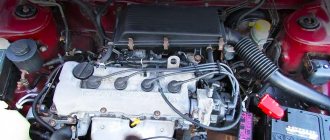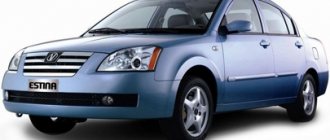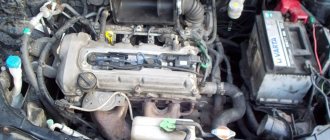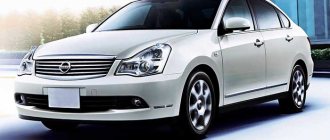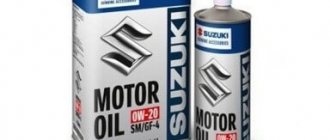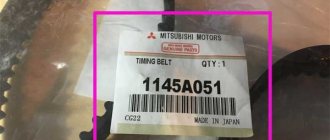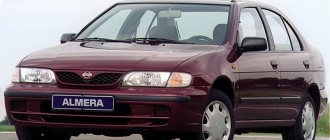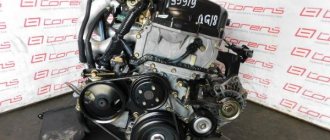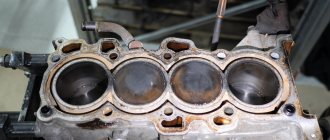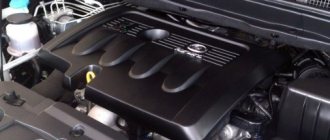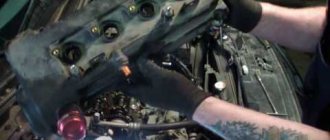Used Nissan Almera Classic: reliable automatic transmission and capricious chassis
In the first part of our review, we were already convinced that a used Almera Classic should not ruin its new owner. In any case, you won’t have to spend a lot on welding and painting for quite a long time. What about the suspension, electrics, engines and gearboxes? Is everything really that rosy?
Electrics
The system does not cause any particular trouble, but, nevertheless, you need to be prepared for the fact that you will need to solder the relays and some control and switching units. In general, relay and fuse blocks sometimes live their own lives; sometimes you have to “distort” the relays and fuses in search of problems. But this is after five or six years of operation. Otherwise, the simple system does not cause serious difficulties.
The most serious problems are a faulty immobilizer, glitches of the car’s electric fans and failures of the ABS electronics. Minor problems with the pressure sensor of the air conditioning system and pressure in the power steering were resolved after 2008. Almost all of them are well-versed in repairs and will not cause any hassle when contacting a specialized service center. The immobilizer usually requires a power reset, and if the error occurs frequently, the antenna must be replaced. The fans suffer due to broken wiring, and the ABS unit suffers due to internal soldering and broken sensor wires at the bend in the wiring.
Pictured: Nissan Almera Classic '2006–12
The generator resource is usually at least 150 thousand kilometers, only when operating in northern and particularly dusty regions do problems occur more often. And everything is usually inexpensive to repair. The resource of the alternator belt may not be too long: after 50 thousand kilometers it is recommended to check it for cracks, and by a hundred thousand it will have to be replaced. But replacement is inexpensive, so this can hardly be called a serious drawback.
The light relay in the driver's feet may short out, resulting in a burning smell in the cabin and malfunctions of the engine ECU. The problem is typical, and if the car is older than 2008, it will almost certainly need replacement. Loaded electrical connectors are not particularly durable: this affects the wiring of the headlights, foglights and heated rear window. It is worth checking them at every maintenance and, of course, when purchasing.
The wiring of the trunk lid is surprisingly vulnerable; failures occur frequently, usually due to a break in the wires inside the corrugation. On cars with a rare option for heating the wiper parking area, the system control unit may fail - it turns on the heating at full strength, and the glass may crack and the heating filaments may burn out. Mostly the problems are minor and do not affect the capabilities of the machine, but, nevertheless, they reduce the feeling of quality.
Brakes, suspension and steering
The brake mechanisms are quite reliable, but the original parts do not have a good service life. Front wheel pads can last only 20-30 thousand kilometers before replacement. With rear drums it’s a little easier: the life of the pads is at least 50-60 thousand, and the drums last twice as long. Hoses and tubes do not cause any trouble, but the ABS system sometimes malfunctions - do not rush to repair the unit itself, often the reason is one of the sensors or even the wiring connector. And power failures cause the system to operate incorrectly - repair the generator if it does not produce a stable voltage.
Pictured: Nissan Almera Classic '2006–12
The suspension is simple, but there is still quite a lot of hassle with it. Firstly, the front and rear levers are supposed to be changed only entirely. Repair is possible, but original components will not be available. The A-pillar supports do not last more than a hundred thousand, and on primers their service life is even less. And the most painful place is the shock absorbers. They are prone to leaks, after which the car’s already poor handling becomes simply dangerous.
The car does not have a standard anti-roll bar, although the related Samsung SM3 has one, and the part can be supplied. The parts are inexpensive, and the levers at the front can be supplied from a “European” car, for which many analogues are produced. However, the suspension will always require attention, and with regular trips with a full load, the service life of the rear shock absorbers is reduced to a ridiculous 15 thousand kilometers: they will leak literally after every maintenance. But the problem can be solved - it is enough to supply parts manufactured by Kayaba or SACHS once. Both comfort and reliability will increase: this is exactly the case when the original parts turned out to be very unsuccessful.
The steering fails mainly at mileages exceeding one and a half hundred thousand. The main risks are associated with weak rack boots and the low service life of the power steering pump. The pump begins to hum and drive chips into the rack, after which its cuffs fail. Well, damage to the anthers leads to corrosion of the rack and the rapid appearance of knocking noises. Let me also remind you that the steering column and its joints are responsible for some of the play.
Transmission
In fact, the car has no particular problems with the body, interior, electrical, suspension and brakes. Everything was done on a very budget, simple, but very reliable. Yes, it breaks, but it's inexpensive. But with a manual transmission, surprises are possible.
Most Almera owners consider the box to be an “eternal” unit and are very surprised when it fails. There were even rumors that the problem was insufficient oil level in the manual transmission, but the essence of the breakdowns usually speaks of something else: cheap bearings and poor material of synchronizers and clutches are poorly adapted to our traffic jams and frequent violation of the speed limit.
A typical repair is actually replacing the bearings of both shafts, replacing the second and third gear synchronizers and replacing the fourth and fifth clutches. In addition to this, the operation of the gear shift mechanism causes criticism: even from the assembly line it is not distinguished by its accuracy, and after hundreds of thousands of miles the owner can feel what the Ikarus driver experienced when sticking gears “by touch”.
Fans of “mechanics” are plagued by problems with the clutch master cylinder, the design of which is not very successful. It leaks, so when purchasing, carefully inspect the vacuum booster, and if there are any leaks, expect a replacement. The part is difficult to repair: it will require not only replacement of seals, but also modification of metal surfaces.
Oddly enough, automatic transmission is more reliable than manual transmission. The proven RE4F03A series gearbox was installed on the Almera Classic. This four-speed transmission traces its “ancestry” back to fully hydraulic automatic transmissions and is characterized by excellent mechanical reliability. Of course, the floating blocking of the gas turbine engine noticeably reduces the oil life during active movement and causes early contamination of the valve body, and the operating temperature is too high, but these are solvable difficulties.
The box is capable of traveling 250-350 thousand kilometers before the first repairs and has a good margin of safety. The main malfunctions are related to the life of the valve body solenoids and cases of oil loss and overheating. It is possible that with mileages of about 150-200 thousand it will be necessary to replace the gas turbine oil seal and change its blocking linings if the degree of oil contamination quickly increases and there are smudges. With very high mileage - over 500 thousand - typical resource problems with the bushings of the pump and rear planetary gear are possible.
Reliability and engine life of Nissan Almera 1.4, 1.5, 1.6, 1.8
The Nissan Almera model debuted in 1995 and replaced the Nissan Sunny on the assembly line. It lasted on the assembly line for 5 years, surviving one restyling in 1998. In 2000, it was replaced by the second generation Almera. Both generations had, although not very extensive, a sufficient choice of engines. Also, their characteristic feature was the high level of equipment even in the basic versions.
In 2006, the second generation was replaced by the Almera Classic, but it was not a direct evolution. At its core, the model was a redesigned version of the Korean Samsung SM3. The platform and main components and assemblies were “shared” by colleagues from the concern from Renault.
In 2012, the French-developed BO platform came in handy once again. Developed on its basis, Almera G15 entered the market.
First generation
Produced from 1995 to 2000. In fact, Nissan Almera became a replacement for the Nissan Sunny and Nissan Pulsar, which by that time had been in production for almost 30 years and were simply obsolete. The car was created to whet the interest of the buyer, who began to disappear in these cars.
The first versions of Almera were equipped with 1.4-liter (GA14DE) and 1.6-liter (GA16DE) gasoline engines; in addition, the engine line included one diesel unit with a volume of 2 liters (CD20).
The diesel engine was installed on cars for Europe; Almera was not supplied to Russia with such an engine. A year after the start of sales, the manufacturer added another gasoline internal combustion engine to the Nissan Almera gasoline powertrain lineup. This is a GTi engine with a displacement of 2.0 liters SR20DE (this engine was also aimed at the Old World; cars with such an internal combustion engine were not officially sold in Russia).
With all engines except the new SR20DE, the model was available as a hatchback (three and four doors) and a sedan. And the version with the GTi engine was sold only as a three-door hatchback. The first generation had excellent sales ratings around the world in the hatchback body.
All first-generation cars already had power steering, a driver's airbag, electric rear-view mirrors and a high-quality audio system as standard.
If we talk about richer configurations, they added modified plastic bumpers with built-in fog lights, alloy wheels, and a rear spoiler.
It is worth noting that the 2.0-liter Nissan Almera GTi had its own additional “aggressive” body kit, which was somewhat reminiscent of the stock body kit on the BMW M3 of that time. The body kit included side skirts, plastic wheel arch extensions, the GTi had a slightly higher suspension, and the car was also equipped with front and rear strut braces and had a so-called fast steering rack.
It must be said that the manufacturer was counting on very large sales of the Nissan Almera GTi, but this did not happen, although the car sold well, but did not become a hit and a “bomb” on the market in any of the sales countries.
From 1998 to 2000, a special modernized version of Almera was sold. The bumpers were changed and the body kit was modified; the rear spoiler had an integrated brake light. The changes were not large-scale, they affected “little things”. Another change: the telescopic antenna was moved from the A-pillar on the driver's side to the rear of the roof, and the antenna itself was replaced with a “bee-sting”. On the modified GTi, the optics and front indicators were surrounded by black, this made the car a little “meaner” visually.
The previous body kit had poor reviews for the quality of the plastic; it was brittle and brittle.
The updated body kit began to be made stronger, from new plastic.
That is why a pre-modernized version of the GTi with bumpers of an updated version or without splitters at all is not a rarity or a garage modification of car enthusiasts, it is a factory sales line from the manufacturer.
Second generation
In 2000, the second generation Almera was released. The car was produced in three body versions: a three-door hatchback, a five-door hatchback, and a classic sedan. The design of the model has changed, it has become more modern. The sedan was in great demand in Russia.
Three years later, in 2003, the manufacturer restyled the second generation Almera, the car was given new optics, the front bumper was modified and a new 1.5-liter diesel engine was added to the range of engines.
In addition to this engine, the line of engines of the second-generation restyled Almera included Nissan QG gasoline engines (displacement of 1.5 liters and 1.8 liters, as well as a diesel engine with a turbocharger and direct injection YD22DDT, the displacement of this power plant was 2.2 liters, The buyer was also offered Common Rail - YD22DDTi. The transmission was “mechanical”, “automatic” was installed only on cars with 1.8-liter gasoline engines.
Nissan Almera Classic
This was a development in 2002, and since 2006 the car began to be sold in Russia. In our country, we fell in love with it, and car enthusiasts dubbed it “unkillable.” The difference from the regular Almera is in slightly modified optics; the model was assembled in Korea. The model turned out to be very simple, as the manufacturer intended. This car was supposed to capture the budget car market.
The car is very cheap to maintain. The main components (engine, gearbox) have an extremely long service life. This is a car that you can drive every day and not spend much money on its maintenance. Some of the disadvantages of the car include increased wear of brake pads and discs. Car enthusiasts say that it is sometimes necessary to change the elements of the brake system after 20-25 thousand kilometers.
Powerplant Almera Classic
The third generation Nissan Almera was equipped with a QG16DE engine with the following technical characteristics:
The power unit number QG16DE is stamped on the right side of the cylinder block and is highly susceptible to corrosion. To ensure its readability, apply a protective heat-resistant layer of varnish.
We will consider gasoline consumption on the following trim levels of the Nissan Almera Classic B10:
QG16DE
Weak spots
In principle, the QG16DE power unit of the Nissan Almera Classic is reliable. Disadvantages that appear with high mileage:
Almera Classic power plant maintenance
The QG16DE engine maintenance process involves observing the following intervals for replacing consumables based on mileage:
Replacing spark plugs with QG16DE
Every fifteen thousand kilometers, you should check the condition of the thermal clearances of the valves. The air filter should also be changed annually.
Weak points of the car
The front brake discs are not durable - they can wear out after 50 thousand km.
The paint on the protective plastic door side moldings may chip.
Weak points of the clutch: the return spring on the pedal (it often breaks) and the clutch master cylinder (loses its seal).
The plastic trim and upholstery of the interior are quite high quality and resist the effects of time well - there are no extraneous sounds in the cabin, the velor of the seats is quite wear-resistant. Inside there are many pockets and shelves for various small things. The budget nature of the model can only be felt by the weak sound insulation (starting from 3000 rpm, the sound of the engine persistently makes its way into the cabin), the absence of handles above the rear doorways (offered as an option) and the trunk lid trim (when closing, you can get hurt on the sharp edges of the inside ), as well as non-transformable rear seats (useful trunk volume cannot be increased). As an option, a hatch under the rear seat armrest is available for transporting long items. At the same time, you need about the volume of the cargo compartment of the Almera Classic - one of the largest among its competitors (see photo).
Fan, stop!
The hero of our material was equipped with only one power unit - a 1.6 liter gasoline engine, which was also used on the Nissan Primera (P12). At the same time, the creators eliminated all the weak points of this engine - problems with the catalyst, which led to its premature failure, air flow meters, short-lived timing chain and its tensioner, camshaft and crankshaft sensors. No such problems were noted in Almera Classic engines, but they can still bring unpleasant surprises.
Thus, new cars may experience increased oil consumption. This is caused by a manufacturing defect - cracks in the cylinder head at the seating areas of the valve guides that occur when the guides are pressed in. However, its official dealers will liquidate it under warranty, replacing the cylinder head free of charge.
In addition, the electric fan of the cooling system may surprise you by unexpectedly switching on permanent operation. The cause of the malfunction is not at all related to the cooling system - it is caused by a break in the electrical wiring connecting the power steering pressure sensor, laid near the engine panel. The fact is that this wiring is common for connecting these nodes.
Otherwise, there are no comments about the Almera Classic engine. The only thing that can be criticized for is its considerable fuel “appetite”. According to the passport data, in the urban cycle with “mechanics” it consumes 9.5 liters per 100 km.
The Almera Classic has only one power unit – a 1.6 liter petrol unit.
The Almera Classic trunk volume of 460 liters is one of the largest among its competitors: Kia Cerato sedan - 345 liters, Chevrolet Lacetti - 405 liters, Hyundai Elantra - 415 liters. A significant drawback is the non-convertible rear seats.
It’s convenient that the “spare wheel” is a full-size wheel. In expensive versions there is a hatch for long items under the rear armrest.
Almost equally
Almera Classic was produced with two gearboxes - a 5-speed manual transmission and a 4-speed automatic transmission. In our market, both units are presented in almost equal proportions.
Both gearboxes have proven themselves to be quite reliable, and the “mechanics” do not have the problem with shaft bearings inherent in their predecessor - the Almera Classic is reliable.
Maintenance of both units consists of regular replacement of lubricant: in the manual transmission - every 90 thousand km, in the automatic transmission - 60 thousand km.
Only the clutch can cause trouble. It is equipped with a hydraulic drive, in which the main cylinder is not reliable - it can unexpectedly leak. The problem is solved by replacing the cylinder assembly. Another weak point is the clutch pedal return spring - it often breaks.
In a calm way
Structurally, the suspension is similar to its predecessor - an independent McPherson strut is used at the front, and a semi-independent torsion beam at the rear. It has good energy consumption, confidently copes with the unevenness of our roads, but is not suitable for active driving - due to the lack of anti-roll bar and narrow high-profile standard tires with a size of 175/70 R14, during sharp maneuvers the Almera Classic rolls heavily and creeps to the outside of the turn. Therefore, it is more pleasant to drive it calmly and measuredly.
The advantage of the “chassis” is that it is quite durable. The front suspension consumables (silent blocks, ball joints and bearings) can withstand at least 100 thousand km, and the “rubber bands” of the rear beam are generally considered “eternal”. Mechanics criticized only the shock absorber boots - they are less durable and cracks may appear on them after a mileage of 50 thousand km.
There are no complaints about the steering wheel equipped with power steering - as a rule, it is problem-free, and the ends and tie rods can withstand about 150 thousand km.
Taking into account the budgetary nature of the model, the creators equipped the rear axle with drum mechanisms (ventilated disc mechanisms in front). In the Almera Classic braking system, the front brake discs are not durable enough - even with a measured driving style, they can wear out by 50 thousand km. Failure of ABS sensors was also noted.
As operating experience has shown, Almera Classic does not have any typical problems with the corrosion resistance of the body.
Almera Classic has decent ground clearance - 175 mm. With it you can easily storm curbs and confidently drive along a country road.
The fact that Almera Classic is produced not by Nissan, but by Renault's auto division - Samsung Motors, is indicated by the nameplate on the body.
What's the secret?
Almera Classic is a good budget car. Since it is built on the basis of old Nissan models, the manufacturers were able to eliminate all the weak points in the components and assemblies used in it. Thanks to this, the model turned out to be quite reliable. However, it is important to know that car parts and maintenance are not cheap in Japan. Due to the specific settings of the Almera Classic chassis, we would recommend this car to those who prefer a calm, measured ride.
Story
2000–2006 Nissan Almera (N16) was produced. 09.02 On the basis of Almera (N16) in Korea, the Samsung plant began production of the budget sedan SM3. 02.06 Restyling Samsung SM3. Sales of SM3 have begun in Ukraine and Russia under the Nissan brand. The name of the new model is Almera Classic. 12.11 Almera Classic is still in production.
Total information
| Nissan Almera Classic | |
| From $9.3 thousand to $16 thousand. | According to the catalog "Autobazar" |
| Body type | sedan |
| Doors/seats | 4/5 |
| Dimensions, L/W/H, mm | 4510/1710/1440 |
| Base, mm | 2535 |
| Curb/full weight, kg | 1160/1700 |
| Trunk volume, l | 460 |
| Tank volume, l | 55 |
Engines | |
| Petrol 4-cylinder: | 1.6 l 16V (107 hp) |
Transmission | |
| type of drive | front |
| KP | 5-st. fur. and 4 tbsp. auto |
Chassis | |
| Front/rear brakes | disk. fan/drum |
| Suspension front/rear | independent/semi-dependent |
| Tires | 175/70 R14, 185/65 R15 |
| Prices for new non-original. spare parts, UAH* | |
| Front/rear brake pads | 270/320 |
| Air filter | 75 |
| Oil filter | 65 |
| Shock absorber front/rear | 1555/550 |
| Front/rear bearing hubs | 250/900 |
| Spherical bearing | 180 |
| Silent block of the front lever front/rear. | 75/85 |
| Front bushing/strut stabilizer | 75/160 |
| Tie rod end | 175 |
| Clutch kit | 2500 |
| water pump | 1025 |
| Valve train chain | 1350 |
| Timing chain tensioner | 360 |
| *Prices may vary slightly depending on the manufacturer and modification of the vehicle. Prices provided by the E99 Route store | |
Description and properties of the Almera Classic engine
This power unit has a Euro-4 standard for environmental friendliness. Photos of the Nissan Almera Classic engine can be found on the Internet. Its motor is made of aluminum, it is lightweight, due to which the final design has a significantly lower weight compared to most other engines of a similar structure.
Read more: Support bearing Santa Fe 2
Due to the lower weight, manufacturers managed to reduce wear on the front suspension and extend its service life.
The decorative engine cover for the Nissan Almera Classic is usually purchased separately. Experienced motorists say that the expensive Korean Almera cover can be replaced with a cheaper and suitable-sized part from the Nissan Primera P12 1.8. The cover is almost completely identical, but one of its four mounting holes is located in a different place. With the others there is no such problem and the cover is attached quite tightly to the power unit.
Nissan Almera Classic engine characteristics:
- Volume – 1.6 l
- Power – 107 hp
- Revolutions in min. – 3.6 thousand
The Nissan Almera engine is equipped with a chain drive, the service life of which is from 200 to 300 thousand km.
Third generation
In the summer of 2012, Renault Nissan began assembling test units, production was established in Togliatti (), the car is based on the 2005 platform. Serial production of the car began at the end of 2012.
The car already traditionally looked stylish, modern, but without any frills. A simple and reliable car for the whole family for every day. The engine available for this car is a K4K petrol power plant, the engine displacement is 1.6 liters (102 horsepower), the engine is paired with either a manual gearbox or a classic automatic transmission.
As for the Russian assembly, which is often criticized. There is nothing terrible about the Russian assembly of Nissan Almera. The car itself was positioned as a budget car. That is, this is a car with less than ideal handling, poor sound insulation and other errors. Our Russian assembly did not spoil anything. There is no need to be afraid of it in this particular model.
The third generation of Almera is available only on the Russian market. The car is produced only in a sedan body.
Which Almera to buy
You need to choose according to the condition of the car, and not according to the year of manufacture or some other parameter. Reviews of the cars characterize them as very reliable and unpretentious cars. Chain motors do not require chain replacement for a very long time. And if you service the car on time, the oil problem will begin to appear no earlier than 250-300 thousand kilometers. And then, oil consumption will be within the normal range from replacement to replacement.
If we talk about diesel engines, they are just as very reliable as gasoline internal combustion engines. Of course, if you buy a poorly maintained or “tormented” car, then you can have personal experience with all the problems of a “diesel”, in the form of a broken cylinder head gasket and all the ensuing problems, including the cooling system and other troubles.
Adjustment of valves
To extend the life of the engine, it is necessary to monitor the condition of the timing drive, as well as adjust the gap in the gas distribution system. The adjustment process should only take place with a cold engine.
Read more: Review of UAZ Patriot 2021
The cylinder block has a head cover that must be removed.
It is worth noting that the cylinder head (cylinder head) is protected by this cover from any negative influences, as well as clogging, so be careful with this cylinder head cover.
Further sequence of actions:
- We turn out the spark plugs.
- It is necessary to set the TDC mark of the first cylinder of the compression stroke.
- Using feeler gauges, we check all the gaps that are located between the adjustment washers, as well as the shaft cams (needed for distribution) in the drive of the first and second cylinders, the intake and exhaust valves of the first and third cylinders.
- We turn the crankshaft one turn and place one mark opposite each other on the pulley, as well as on the cylinder block.
- We check the clearances of the intake (third and fourth cylinders) and exhaust (second and fourth). You also need to write down the data, comparing them with the recommendations: intake – 0.32–0.40 and exhaust – 0.37–0.45.
We collect in the opposite order. It is necessary to check the performance of the engine.
Service
Maintenance of the Nissan Almera engine is no different from standard power units of this class. Engine maintenance is carried out at intervals of 15,000 km. Recommended maintenance must be performed every 10,000 km. So, let's look at the detailed technical service map:
TO-1: Oil change, oil filter replacement. Carry out after the first 1000-1500 km. This stage is also called the break-in stage, since the engine elements are grinding in.
TO-2: The second maintenance is carried out after 10,000 km. So, the engine oil and filter are changed again, as well as the air filter element. At this stage, the pressure on the engine is also measured and the valves are adjusted.
TO-3: At this stage, which is performed after 20,000 km, the standard procedure for changing the oil, replacing the fuel filter, as well as diagnosing all engine systems is carried out.
TO-4: The fourth maintenance is perhaps the simplest. After 30,000 km, only the oil and oil filter element are changed.
TO-5: The fifth maintenance is like a second wind for the engine. This time a lot of things are changing. So, let's look at which elements need to be replaced in the fifth maintenance:
- Change of oil.
- Replacing the oil filter.
- Replacing the air filter.
- Replacing the fuel filter element.
- Alternator belt if necessary.
- Water pump.
- Valve cover gasket.
- Other items that need to be replaced.
- Valve adjustment, which adjusts the gas distribution mechanism.
Subsequent maintenance is carried out according to the 2-5 maintenance map for the corresponding mileage.
Disadvantages, breakdowns and problems of Nissan QG16DE
Dips in traction appear due to stretching of the timing chain; it lasts about 150,000 km
Engine speed usually fluctuates due to contamination of the throttle or USR valve
The alternator belt has a rather small resource and only replacement helps it
There are no hydraulic compensators here, so the valves require periodic adjustment
Cases of destruction of the catalyst, crumbs of which were drawn into the cylinders, are described
- You can contact the site administrator by email: [email protected]
All texts were written by me, are authored by Google, included in the original Yandex texts and notarized. For any borrowing, we immediately write an official letter on company letterhead in support of search networks, your hosting and domain registrar.
Next we go to court. Don’t try your luck, we have more than thirty successful Internet projects and have already won a dozen lawsuits.
Read more: How to properly seal an electronic speedometer on a UAZ
Judging by many reviews, the Nissan Almera Classic is a pretty good car. It rarely breaks down, even if it does, the reason is careless car care, for example, using bad oil and gasoline or incorrectly changing the oil, that is, the owner’s fault.
Typical problems
We have already talked about poor noise insulation and increased wear of brake pads and brake discs. It has also already been said that after 250,000 kilometers, the engine begins to eat a little oil.
The metal of the car is not of the highest quality, but it is certainly an order of magnitude better than on our domestic cars. You can easily find the first generation Nissan Almera, which has traveled around Russia all its life and still has no serious problems in terms of metal corrosion.
When buying a car, listen to the engine, if it is running rough, then this may be a very serious problem; it may be worth considering another car for purchase, rather than doing repairs for the previous owner.
It is also recommended to always monitor the oil level to avoid serious problems one day. In general, the car is of very high quality and worthy, especially for the money that is asked for it on the secondary market. Consumables and components are sometimes downright cheap.
In general, almost all Nissan Almera repairs can be done independently. The machine is simple and repairable.
Description of engine problems Nissan Almera Classic
- Problems with the timing belt: some Almeria owners note that, despite the impressive service life of the chain drive, the timing belt can fail much earlier. Troubles are associated with loss of tension, as a result of which the chain has to be replaced with a new one. This problem most often occurs at 60-70 thousand kilometers.
- Problems with the camshaft sensor: another common problem with Almera engines is that they suddenly begin to stall after 150 thousand km. This problem can be fixed relatively simply - you need to turn the camshaft clockwise.
- Problems with engine drive belts: during operation, sometimes a whistling sound occurs in the engine belt. To avoid this, it is necessary to change the belts according to the regulations and be sure to undergo scheduled maintenance.
- Problems with noisy operation: if at low speeds the engine is almost inaudible, then from medium speeds and above it begins to emit a monotonous, rather unpleasant sound that can get on your nerves.
The Nissan Almera Classic inherited the engine from the earlier Nissan Primera. When describing it, it should also be mentioned that this engine has economical fuel consumption and good traction even at low speeds.
For the Classic engine, 92 gasoline is suitable.
The QG16DE engine is installed on a five-speed manual transmission and a four-speed automatic transmission, providing both models with fast and smooth acceleration.
You can find even more information about the heart of the Almera car in the article “Nissan Almera Engine”.
A little about the power unit
The Almera engine is designated QG16DE. Four cylinders are mounted transversely in the engine compartment. The Nissan Almera Classic engine has 16 valves, and it was also installed at the front of the car under the hood.
The creators installed a standard called Euro-4 on the Nissan Almera Classic 1.6 engine, which belongs to the class of high environmental friendliness. Due to the fact that the motor is made of a light aluminum alloy, its weight has become much less when compared with other engines with a similar structure. This motor, which has significantly less weight than others, has increased reliability, and the load on the front axle has also been reduced, thanks to the same weight.
The decorative engine cover for Nissan Almera Classic has to be purchased separately. The Korean Almera cover is very expensive, but many experienced people replace it using a cheap, suitable-sized Nissan Example. It is almost completely similar to the expensive one, but the fastening is located in a different place, and there are only four of them. But, as a rule, there are no problems with the remaining holes, and the cover is completely attached to its place. This engine has a chain drive.
The supports of the power unit take a considerable load during the start; they experience especially strong overloads when the driver starts to slip. It follows that engine mounts need to be replaced periodically.
You should not start moving very abruptly, since there is an element that will quickly wear out if you do this. This element is called the engine mount.
Main characteristics of the Nissan Almera Classic engine:
Working volume – 6 l.
Engine life is 200–300 thousand kilometers. But if we delve deeper into this problem, we can conclude that Nissan engines are very good. It doesn’t matter what the engine resource is, because if you try, any engine can be killed in one or two or three days. Therefore, if you take care of your engine (timely changing oil and filters), then it will work for a long time, without problems.
Nissan Almera engines
| 1st generation | 2nd generation | 3rd generation | Almera Classic | |
| K4M (1.6 liter 102 hp) | — | — | + | — |
| QG16DE (1.8 liter 107 hp) | — | — | — | + |
| QG15DE (1.5 l, 90 hp) | — | + | — | — |
| QG18DE (1.8 l, 114 hp) | — | + | — | — |
| QG15DE (1.5 l, 98 hp) | — | + | — | — |
| QG18DE (1.8 l, 116 hp) | — | + | — | — |
| GA14DE (1.4 l, 87 hp) | + | — | — | — |
| GA16DE (1.6 l, 99 hp) | + | — | — | — |
| CD20 (2.0 l, 75 hp) Europe | + | — | — | — |
| SR20DE (2.0 L, 143 hp) Europe | + | — | — | — |
It is worth saying that throughout the history of Nissan Almera, the buyer has been offered a sufficient number of different power units. If you pay attention, there were two engines that were exclusively installed on the first generation of the car supplied to Europe. These were CD20 and SR20DE engines. In our country there are Almerias with such engines, but rarely. These are independently imported cars from European countries. There have never been official deliveries of such cars with these engines to Russia.
Technical characteristics of Nissan Almera >
sedan
- width 1,710mm
- length 4 510mm
- height 1,440mm
- ground clearance 165mm
- seats 5
| Engine | Name | Price | Fuel | Drive unit | Consumption | Up to a hundred | Max. speed |
| 1.6 MT (107 hp) | pe+/-a— | ≈ 518,000 rub. | AI-95 | Front | 5,3 / 9,2 | 12.1 s | 184 km/h |
| 1.6 MT (107 hp) | se/—-j | ≈ 569,000 rub. | AI-95 | Front | 5,3 / 9,2 | 12.1 s | 184 km/h |
| 1.6 MT (107 hp) | pe/—– | ≈ 473,000 rub. | AI-95 | Front | 5,3 / 9,2 | 12.1 s | 184 km/h |
| 1.6 MT (107 hp) | pe/–c– | ≈ 502,000 rub. | AI-95 | Front | 5,3 / 9,2 | 12.1 s | 184 km/h |
| 1.6 MT (107 hp) | pe+/aa–b | ≈ 540,000 rub. | AI-95 | Front | 5,3 / 9,2 | 12.1 s | 184 km/h |
| 1.6 AT (107 hp) | pe+/-a— | ≈ 548,000 rub. | AI-95 | Front | 6 / 10,4 | 13.9 s | 177 km/h |
| 1.6 AT (107 hp) | se/—-j | ≈ 599,000 rub. | AI-95 | Front | 6 / 10,4 | 13.9 s | 177 km/h |
| 1.6 AT (107 hp) | pe+/aa–b | ≈ 570,000 rub. | AI-95 | Front | 6 / 10,4 | 13.9 s | 177 km/h |
